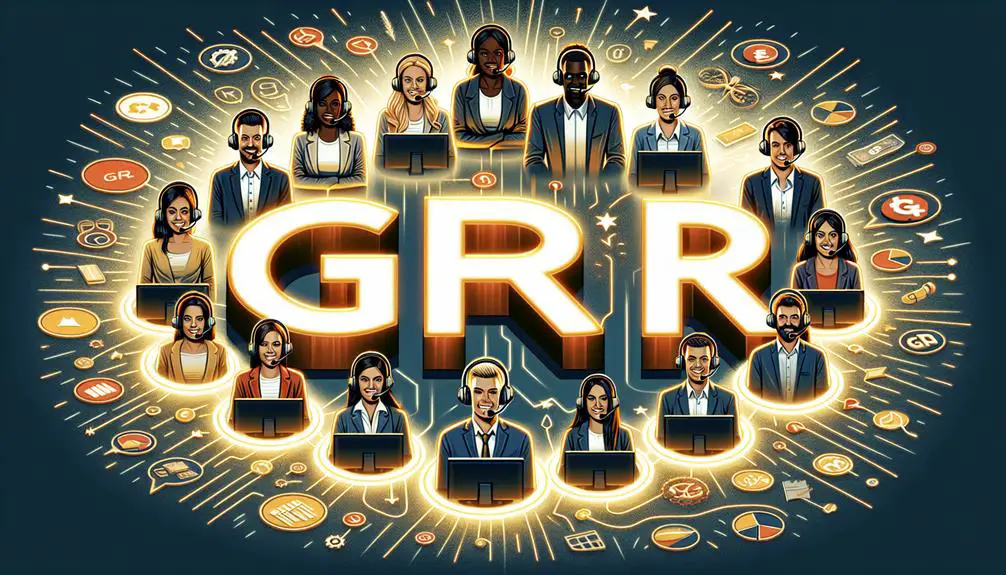You might think that Gross Revenue Retention (GRR) is just another financial metric with limited application, but it's far more pivotal than you'd initially believe. Understanding GRR gives you an inside look at your business's health, highlighting customer satisfaction and loyalty without the noise of new sales.
By grasping its nuances, you'll uncover strategies to not only retain customers but also to significantly boost your company's financial stability. This guide doesn't just explain the what and the how; it equips you with actionable insights to transform these metrics into real-world success.
Imagine the advantages you'll hold by mastering the art of revenue retention, and let's explore how to achieve this together.
Contents
- 1 Key Takeaways
- 2 Understanding GRR
- 3 Calculating GRR
- 4 GRR Vs. NRR
- 5 GRR Formula Explained
- 6 Example GRR Calculation
- 7 Significance of GRR
- 8 Impact on Investment Decisions
- 9 Strategic Planning With GRR
- 10 Improving GRR Strategies
- 11 Customer Support's Role
- 12 Analyzing Customer Feedback
- 13 Enhancing Customer Experience
- 14 GRR Improvement Tactics
- 15 Industry-Specific Strategies
- 16 Leadership and GRR Goals
- 17 Frequently Asked Questions
Key Takeaways
- GRR measures a company's success in retaining revenue from existing customers, highlighting customer satisfaction and resilience.
- Accurate GRR calculation is essential for strategic decisions aimed at improving customer retention and reducing churn.
- GRR differs from NRR by focusing solely on revenue retention, making it crucial for assessing the stability of a customer base.
- High GRR percentages signal a stable customer base, attracting potential investors and influencing positive investment decisions and ROI.
Understanding GRR
To truly grasp the essence of GRR, or Gross Revenue Retention, it's crucial to understand how it acts as a SaaS company's lifeline, measuring its success in retaining existing customers' recurring revenue. This metric shines a light on the company's ability to maintain its revenue stream despite the inevitable customer churn and downgrades that every business faces. Think of it as a health check for a company's customer retention strategy, providing a clear picture of how well it's managing to keep its revenue from existing customers intact.
A higher GRR percentage is a testament to a company's resilience and its ability to satisfy its customer base. It's not just about holding onto customers; it's about maintaining the level of revenue those customers generate. In the dynamic landscape of SaaS, where competition is fierce, and customer expectations are high, GRR becomes an indispensable part of a company's vocabulary. It guides strategic decisions, helping businesses identify where they need to improve their offerings or customer service to reduce churn and prevent downgrades.
Understanding your GRR is the first step towards crafting a powerful customer retention strategy that ensures revenue retention and paves the way for sustainable growth.
Calculating GRR
Now that you've got a grasp on what GRR means, let's break down how you can calculate it step-by-step.
We'll walk through the GRR formula, outline the specific steps for calculation, and highlight some common mistakes to avoid.
This way, you'll be better equipped to understand your business's revenue retention and where it might be leaking.
GRR Formula Explanation
Understanding the GRR formula is key to measuring how effectively your business retains revenue from current customers. Gross Revenue Retention (GRR) zeroes in on the percentage of recurring revenue you keep from existing clients.
You'll subtract churned and downgraded revenue from your starting Monthly Recurring Revenue (MRR) to find this figure. It's a vital metric, shining a spotlight on the success of your customer retention strategies.
By grasping the GRR formula, you gain insight into how lost revenue impacts your overall revenue stability. Essentially, a higher GRR percentage is a sign of strong customer retention and revenue resilience.
This knowledge enables you to refine strategies for maintaining, if not improving, your business's financial health.
GRR Calculation Steps
How do you calculate GRR to gauge the success of your customer retention efforts effectively? By understanding the calculation steps, you can master strategies for revenue retention and stability. Here's how:
- Identify the Beginning MRR: The monthly recurring revenue at the start.
- Calculate Churned MRR: Revenue lost from customers who leave.
- Determine Downgrade MRR: Revenue lost from customers moving to lower plans.
- Subtract Churned and Downgrade MRR from Beginning MRR: This gives you the net revenue retained.
- Divide by Beginning MRR: The result is your GRR percentage.
Calculating GRR helps you pinpoint where your retention strategies may need fortification, ensuring the stability of your revenue stream.
Common GRR Mistakes
Calculating GRR accurately is crucial, yet many businesses fall into the trap of common errors that skew their insights into customer retention. Missteps, such as inaccurately calculating churned MRR and downgrade MRR, lead to distorted views of how well you're keeping customers.
Accurate GRR calculation is indispensable for understanding revenue stability and the effectiveness of your customer retention strategies. If you're not precise, you might miss underlying issues with customer churn and revenue loss, masking problems that need urgent attention.
Ensuring precision in your GRR calculation provides you with reliable insights for strategic decision-making, helping you to avoid pitfalls and make informed choices that safeguard your revenue and bolster customer loyalty.
GRR Vs. NRR
When comparing GRR and NRR, it's crucial to note that while GRR zeroes in on the revenue from existing customers, NRR offers a broader picture by including expansions, contractions, and upgrades. This distinction is pivotal for you to understand the nuances of financial performance, especially in how revenue dynamics play out in the real world of business.
- Gross Revenue Retention (GRR) focuses strictly on the revenue you retain from existing customers, excluding any revenue fluctuations due to expansions or contractions.
- Net Revenue Retention (NRR), on the other hand, incorporates expansions, contractions, and upgrades, providing a more comprehensive view of revenue health.
- Investors and operators lean towards NRR as it paints a fuller picture of a company's growth potential and customer value expansion.
- GRR becomes particularly important in scenarios of low customer acquisition, shining a light on customer base resilience.
- NRR with a median of around 104% for private companies, signals not just stability but growth from existing clientele.
Understanding the interplay between GRR and NRR helps you grasp the broader implications of customer behavior on revenue, guiding strategic decisions and investor communications.
GRR Formula Explained

To understand your business's ability to retain revenue from current customers, it's crucial to grasp the GRR formula. This formula is a straightforward yet powerful tool for measuring how well you're maintaining your revenue streams without the influence of new sales or upsells. It's calculated as (Beginning MRR – Churned MRR – Downgrade MRR) / Beginning MRR.
Here's what each component represents: Beginning MRR is your monthly recurring revenue at the start of a period. Churned MRR indicates the revenue lost from customers who've decided to cancel or not renew their subscriptions. Downgrade MRR captures the reduction in revenue when customers opt for lower-priced plans.
Example GRR Calculation
Let's dive into an example to see how GRR calculation works in practice, focusing on the revenue you've managed to keep from your existing customers. Suppose your company began the month with a Monthly Recurring Revenue (MRR) of $10,000. During the month, you experienced customer churn and downgrades, losing $2,000 in MRR.
To calculate your Gross Revenue Retention (GRR) rate, you'd follow this formula: (Beginning MRR – Churned MRR – Downgrade MRR) / Beginning MRR. Here's a breakdown:
- Beginning MRR: $10,000
- Churned MRR: $1,500
- Downgrade MRR: $500
- Subtract Churned and Downgrade MRR from Beginning MRR: $10,000 – $1,500 – $500 = $8,000
- Calculate GRR: $8,000 / $10,000 = 0.8 or 80%
This calculation offers a clear insight into how well you're retaining revenue from your existing customers despite the challenges of churn and downgrades. Understanding GRR is crucial because it reflects your company's ability to maintain its revenue base, highlighting the importance of customer retention strategies. By keeping a close eye on this rate, you're better equipped to gauge the effectiveness of your efforts to minimize revenue loss.
Significance of GRR

Understanding the significance of GRR is pivotal in assessing how well your business retains revenue and predicts future growth. This metric isn't just a number; it's a reflection of the effectiveness of your customer retention strategies and revenue retention efforts. By delving into GRR, you're essentially evaluating how adept your business is at keeping its customers over time and how this retention translates into stable revenue.
A higher GRR percentage is a clear indicator of better customer retention and revenue stability. This stability is crucial for predicting future revenue and understanding your business's growth potential. It's not just about the numbers; it's about what these numbers say about your business's ability to maintain and nurture customer relationships.
Moreover, GRR plays a critical role in investors' assessment of your company. They look for businesses that not only attract but also retain customers effectively. This retention is a testament to a company's health and its long-term viability. By focusing on improving your GRR, you're not just enhancing your revenue retention efforts; you're also making your business more attractive to potential investors by demonstrating strong evaluating customer strategies and a solid foundation for growth.
Impact on Investment Decisions
When you're examining the impact of GRR on investment decisions, consider how it influences ROI and enhances risk assessment.
A robust GRR signals to you, as an investor, that a business has a stable customer base, which in turn suggests a more secure investment.
This metric can be a game-changer in deciding where to allocate your resources for maximum returns.
GRR Influence on ROI
GRR's significant role in shaping investment decisions can't be overlooked, as it directly influences a company's ability to secure and grow its revenues from loyal customers. Understanding how GRR impacts ROI is crucial for making informed financial assessments and investment decisions.
- GRR showcases stability, indicating a solid foundation for potential growth.
- High GRR rates are attractive to investors, signaling lower risk and high growth potential.
- Influences ROI calculations, making it a cornerstone in financial assessments.
- Emphasizes the importance of customer retention strategies for long-term success.
- Acts as a barometer for financial health, guiding businesses in securing future investments.
Mastering these concepts will empower you to make smarter investment decisions, ensuring your business remains competitive and financially stable.
Risk Assessment Enhancements
By incorporating GRR metrics into your risk assessment, you can significantly refine how you gauge a company's future revenue stability and customer loyalty. This approach not only sharpens your investment decisions but also brings clarity to potential risks. Let's break down why GRR is a game-changer for investors:
| Aspect | Impact on GRR | Investor Benefits |
|---|---|---|
| Revenue Stability | High | Predictable returns |
| Customer Retention | Crucial | Sustained growth |
| Risk Assessment | Enhanced | Informed decisions |
| Revenue Retention | Core focus | Lower risk profile |
| Investment Decisions | Strategic | Optimized portfolio |
Understanding GRR is vital for spotting red flags in revenue retention, underscoring its importance in crafting savvy investment strategies. It's clear: mastering GRR insights empowers you to make investment choices that align with long-term revenue stability and customer loyalty.
Strategic Planning With GRR

Analyzing customer retention and revenue stability metrics through GRR plays a crucial role in strategic planning processes, helping businesses predict future trends and optimize growth. By understanding how GRR impacts these areas, you're equipped to make informed decisions that boost your company's growth potential and sustainability. Here's why integrating GRR into your strategic planning is a game-changer:
- Predicts Future Revenue Trends: GRR analysis offers a clear view of potential revenue fluctuations, enabling you to adjust strategies proactively.
- Enhances Customer Retention: Insights from GRR guide the development of strategies aimed at improving customer loyalty and reducing churn.
- Improves Decision-Making: GRR data provides a solid foundation for making strategic decisions, ensuring efforts are directed where they're most needed.
- Assesses Revenue Retention Efforts: You can evaluate the effectiveness of current retention strategies and identify areas for improvement.
- Supports Sustainable Growth: By aligning your strategic planning with GRR insights, you set the stage for long-term growth and stability.
Incorporating GRR into your strategic planning isn't just about crunching numbers; it's about creating a resilient business that understands and adapts to its customers' needs, ensuring longevity and profitability.
Improving GRR Strategies
To effectively boost your Gross Revenue Retention, it's crucial to hone in on strategies that elevate customer satisfaction and loyalty. Enhancing the overall customer experience by ensuring reliability and consistency in your business operations is a foundational step. By exceeding customer expectations, you're not just meeting their needs; you're creating an environment where loyalty flourishes. This approach directly contributes to improved GRR, customer retention, and revenue growth.
Maintaining a proactive and efficient customer success team plays a pivotal role in this strategy. Their ability to address customer needs promptly ensures that your business remains responsive and customer-centric. Incorporating regular customer feedback into your operational improvements allows you to fine-tune your offerings, making them more aligned with customer desires.
Implementing loyalty programs can further cement customer relationships, encouraging repeat business and fostering a sense of belonging among your clientele. Moreover, exploring upselling and cross-selling opportunities with a focus on adding value to the customer experience can significantly enhance revenue growth. These strategies, rooted in deepening customer satisfaction, are key to elevating your GRR and ensuring long-term business success.
Customer Support's Role

Building on the foundation of enhancing customer satisfaction for better Gross Revenue Retention, let's explore how effective customer support plays a crucial role in this equation.
You're in the business of not just selling products or services but also building relationships. And in the heart of these relationships lies the trust and loyalty cultivated through excellent customer support.
- Prompt Resolution: Quick and effective solutions to problems not only resolve issues but significantly reduce the churn rate. It shows your customers you value their time and business.
- Trust Building: By consistently providing reliable customer support, you're laying the foundation for deep trust, which is essential for long-term relationships and brand loyalty.
- Enhancing Satisfaction: A satisfied customer is likely to stick around and even become a brand advocate. Effective support ensures customer needs are met, elevating their overall satisfaction.
- Reducing Churn: Every interaction that resolves a customer's concern reduces the likelihood of them leaving for a competitor, directly impacting your Gross Revenue Retention positively.
- Fostering Loyalty: Beyond resolving issues, exceptional customer service experiences create emotional connections, turning customers into loyal fans.
Analyzing Customer Feedback
Frequently, diving into customer feedback reveals invaluable insights that can dramatically shape your business's future. By analyzing customer feedback, you're not just listening; you're learning directly from those who interact with your products or services. This process is pivotal in understanding customer satisfaction levels and pinpointing areas needing enhancement.
Customer feedback is a goldmine of valuable insights. It uncovers preferences, pain points, and detailed accounts of experiences. These are the clues you need to make informed decisions that can elevate your offerings and how you engage with your audience. By prioritizing this feedback, you can adapt and innovate in ways that resonate more deeply with your customers.
Moreover, acting on the data points gathered through customer feedback doesn't just tweak your business operations; it transforms them. Effective analysis leads to higher customer retention rates and fosters loyalty. It's a direct line to what your customers want and how they want it. Ignoring this feedback is a missed opportunity, but embracing it can significantly impact your business growth and revenue retention strategies.
Enhancing Customer Experience

After analyzing customer feedback, it's crucial to focus on enhancing the customer experience, as it's a major driver of loyalty and revenue. Achieving mastery in this area means understanding its profound impact on your bottom line.
Here's how focusing on customer experience can transform your business:
- Increase customer loyalty: By improving the customer experience, you're likely to see loyalty increase by seven times, boosting retention rates significantly.
- Justify premium pricing: A stunning 86% of customers are willing to pay more for a better experience, directly impacting your revenue.
- Influence purchasing decisions: With 73% of customers considering experience an important factor, it's clear that enhancing customer satisfaction can sway buying behavior.
- Boost retention: A strong focus on customer experience correlates with a 20% higher retention rate, showing the importance of prioritizing customer inquiries and feedback.
- Elevate profits: Enhancing customer experience can lead to a 25-95% increase in profits, proving that investing in customer satisfaction pays off.
GRR Improvement Tactics
To improve your GRR, you'll need to implement targeted strategies that not only enhance customer satisfaction but also fortify loyalty and trust. By focusing on building a strong relationship with your customers, you're not just retaining customers; you're creating advocates for your brand. This commitment leads directly to reduced churn rates and a significant boost in revenue retention.
Diving into customer feedback and data is pivotal. It allows you to pinpoint exactly where your product or service can be refined to meet and exceed customer expectations. This continuous improvement cycle ensures that you're always offering a high-value proposition, which is key to enhancing the overall experience.
Moreover, exceptional customer service and support are non-negotiable aspects of a successful strategy. They serve as the backbone of customer retention efforts, ensuring that every interaction leaves a positive impression that contributes to maximizing GRR.
Lastly, don't overlook the importance of developing expansion opportunities and upgrades for existing customers. These initiatives not only enhance customer satisfaction but also open avenues for increased revenue retention, ensuring your business remains competitive and profitable in the long run.
Industry-Specific Strategies

Within each industry, businesses can adopt specific strategies tailored to their sector to effectively boost their GRR. These strategies aren't just about keeping the lights on; they're about building a foundation that ensures your business not only survives but thrives. By focusing on what really matters, you can create a loyal customer base that feels valued and understood, leading to increased revenue stability and growth.
To help you master the art of industry-specific strategies for GRR, consider implementing the following:
- Personalized Interactions: Tailor your communication to meet the unique needs and preferences of each customer.
- Efficient Support: Ensure your customer service team is responsive and capable of resolving issues swiftly.
- Analyzing Feedback: Regularly collect and analyze customer feedback to identify areas for improvement.
- Enhancing Product Quality: Use insights gained from feedback to make meaningful improvements to your product or service.
- Proactive Initiatives: Develop and implement proactive initiatives aimed at customer success, building trust, and fostering loyalty.
Leadership and GRR Goals
Building on the foundation of industry-specific strategies, effective leadership plays a pivotal role in setting and achieving GRR goals. As a leader, you're at the helm, steering your team towards clear objectives for GRR and NRR, crucial for measuring revenue retention success. It's your responsibility to foster collaboration among sales, customer service, and finance teams. This enhances strategies for improving GRR, making your role indispensable in bridging departments for a unified goal.
Encouraging innovative thinking within your teams can lead to creative solutions, boosting revenue retention metrics. It's about pushing boundaries and inspiring your team to think outside the box. Recognizing and rewarding efforts in enhancing GRR and NRR not only motivates employees but also aligns their focus on retention goals. This recognition is a powerful tool in your leadership arsenal.
Cultivating a culture of achievement and motivation is key. It's about driving continuous improvement in revenue retention metrics through a motivated workforce. Your leadership is the catalyst for this environment, where collaboration and innovation thrive, setting the stage for achieving and surpassing GRR goals.
Frequently Asked Questions
What Does GRR Stand for in Business?
In business, GRR stands for Gross Revenue Retention. It's a gauge of how well a company keeps its existing customers' revenue, considering churn and downgrades. A high GRR signals strong customer retention and revenue stability.
What Is the Term Grr?
GRR stands for Gross Revenue Retention, a key metric you'll use to track how well your business keeps its existing customers' revenue, considering churn and contractions. It's vital for assessing your retention strategies.
What Is the Full Form of GRR in Customer Success?
In customer success, GRR isn't just an angry growl; it stands for Gross Revenue Retention. It measures how well you're keeping that cash flowing from existing customers, crucial for your subscription-based empire's stability.
What Is a Good GRR Rate?
A good GRR rate varies by business type. For SaaS companies, aim for around 90%, but if you're targeting small/medium businesses, 80% is solid. Striving for as close to 100% as possible indicates success.

